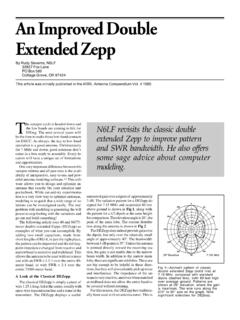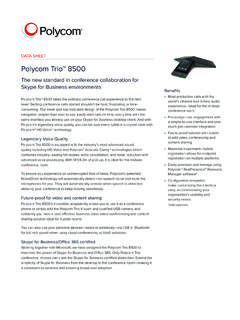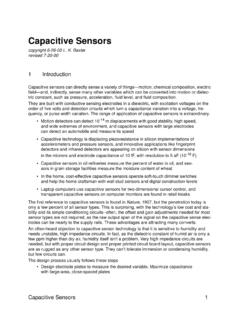Transcription of Snubber Circuits For Power Electronics
1 Snubber Circuits For Power Electronics Rudy Severns 1. 2. Snubber Circuits For Power Electronics Rudy Severns 3. Copyright 2008 Rudolf Severns All rights reserved. No part of this publication may be reproduced, stored in a retrieval system or transmitted in any form or by any means, mechanical, photo-copying, recording or otherwise, without prior written permission of Rudolf Severns. Legal notice: Great effort has been made to make the material presented in this book as accurate as possible. However, the author and publisher assume no responsibility or liability whatsoever on behalf of any Purchaser or Reader of these materials. It is the responsibility of the user to exercise good engineering judgment when using this material.
2 A note from the author. Preparing a book like this takes well over 1000 hours of effort and a substantial investment by the author and publisher. Hopefully, this book will prove to be a useful contribution to the Power Electronics art. When such books are successful and provide some reasonable return to their authors, there is motivation to write more such books on other important subjects. The result is of benefit to all in our profession. Honesty is a fundamental requirement for any professional engineer and is expected of those in the profession or training for it. Your help is requested in not making copies of this work and distributing it to others or in accepting any such copy. 4. Table of contents PREFACE 7.
3 ACKNOWLEDGEMENT 11. CHAPTER 1 13. An Overview Of Snubbers 13. What is a Snubber ? 21. Classifying snubbers 22. Snubber trade-offs 24. CHAPTER 2 25. Things You Need To Know About Switches 25. The ideal switch 25. A generalized switch concept 27. Real switches 27. Switch operating quadrant 30. The load-line concept 31. SOA concept 32. Derating and SOA 34. Switching scenarios 35. Resistive load switching 35. Clamped inductive switching 37. Unclamped inductive switching 45. capacitive switching 48. Switching with real loads 51. Effect of parasitics on circuit waveforms 52. Unintentional overlapping conduction in switches 56. Lack of desired overlapping conduction 60. CHAPTER 3 61. RC -snubbers 61. Examples of RC- Snubber use 61.
4 A closer look at RC- Snubber behavior 69. Finding the optimum value for Rs 72. Choosing Cs 76. A design example 80. CHAPTER 4 87. Dissipative RLC-diode snubbers 87. Basic circuit 88. A Turn-off Snubber 90. Parasitic inductance and the turn-off Snubber 102. The turn-on Snubber 104. Turn-on Snubber with a real diode 112. 5. The combination Snubber 118. A simplified combination Snubber 122. Waveform discontinuities 126. Choosing the initial Snubber component values 128. Snubber interactions 136. Non-linear Ls and/or Cs 147. CHAPTER 5 151. Energy recovery snubbers 151. A turn-off Snubber example 152. Turn-on Snubber example 1 164. Turn-on Snubber example 2 184. Combination energy recovery snubbers 189. Combination Snubber example 1 191.
5 Combination Snubber example 2 193. A flyback converter Snubber 215. Energy recovery snubbers for bridge connections 222. CHAPTER 6 225. Component selection and circuit layout 225. Diode selection 227. Ls design 228. Cs selection 231. Rs selection 235. Effect of parasitic L on Snubber behavior 239. Package and layout inductance 243. Comments on measurements 246. One final reminder 252. CHAPTER 7 253. Bare Bones Snubber Design 253. Getting started 254. Example circuit 255. Circuit waveform and Power loss survey 257. Example 1, an RC- Snubber 263. Example 2, another RC- Snubber design 267. Example 3, more RC- Snubber 269. Example 4,a turn-off RC-diode Snubber 272. Example 5, a combination turn-on and turn-off Snubber 279.
6 Example 6, an energy recovery Snubber 284. Component values 291. Summary 294. TECHNICAL LITERATURE BIBLIOGRAPHY 295. Snubber PATENT BIBLIOGRAPHY 339. INDEX 345. 6. Preface Switches play a major role in efficient Power conversion and have a long history of use beginning with mechanical switches in the 1840's, vacuum and gas discharge devices during the first 60 years of the 20th century, through to today's wide variety of semiconductor devices. While switching device technology has changed dramatically over time, the need to use some form of auxiliary circuit to reduce switch stress and/or losses has been constant. In fact some of these auxiliary Circuits , which are often referred to as "snubbers" or "switching aids", are the same today as they were in the 1850's, using the same components, in the same way, for the same reasons.
7 Of course there have also been many new ideas as switch technology has evolved. Despite this long history, new and useful Snubber variations still continue to appear. We still haven't invented everything when it comes to snubbers. With so much activity over such a long period of time it's not surprising that there is a very extensive body of technical literature and patents on snubbers. As part of this book I have included an extensive bibliography (with over 500 entries!) but that's just a sample of the literature on the subject. Surprisingly, it does not appear that anyone has written a book on snubbers although there have been multi-page applications notes[388,441]. Although most Power Electronics texts at least touch on the subject of snubbers, for the most part we still have to search through the literature to get detailed information on snubbers and their applications.
8 This lack of a text which provides information on the design of snubbers and points the way to the wider literature is my motivation for creating this book. In the process I learned a very great deal which I wish I had known much earlier. There is no pretence that this book is a complete source even though the subject is discussed at book length. Because of the breadth of the subject and the incredible variety of Snubber Circuits , all I've been able to do in the space available is to illustrate basic principles, 7. describe the operation of typical examples, point out the similarities between many apparently different snubbers and give design guidance for some typical Snubber Circuits . To make the text more readable and accessible, I have elected to devote very little space to detailed analytic derivations of the equations describing circuit waveforms and operation.
9 The literature is rich with such expositions and where appropriate I identify relevant references. This should allow the reader to gain a basic understanding of the operation of a particular Snubber from the text and then proceed to related literature for more detailed information. Besides space, there are other reasons for limiting the analytic discussion. As indicated in chapter 2, even for as simple a Snubber as the RC-damping network, the analysis quickly becomes very complicated, especially when real circuit details, such as multiple distributed parasitics and the actual behavior of semiconductor devices during switching are included. From the point of view of designing and applying snubbers in the laboratory, often in some haste, it is much faster to use approximate expressions which will get you close to a solution and then adjust component values to optimize performance.
10 I must admit that for years I have railed against this kind of cut-and-try design process in Power Electronics . In the case of snubbers however, I've had to admit that in the usual pressure- cooker environment where a problem is discovered during development and a quick fix is needed, this approximate approach works very well. More detailed analysis for the final product can (and should!) be done later. The literature is full of such analysis, particularly in papers with academic origins. But when the pressure is on, even the relatively simple discussions of circuit operation which constitute most of this book, may be too involved. You may only want to know the time of day, not how to design the watch! To meet this need I have included a separate chapter entitled "Bare Bones Snubber Design".






